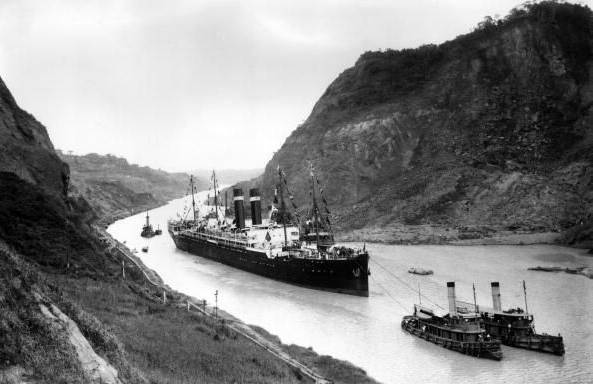*Image Credit: Wikimedia Commons Though first begun in 1881, workers on the Panama Canal – one of the world’s most important waterways – did not begin laying concrete until August 24, 1909. After more than five years and countless loads of dirt, the canal reached an important milestone when the heavily-fortified walls began taking shape. It would take another five years of work, but the shortcut across Central America between the Gulf of Mexico and the Pacific Ocean would open for business on August 15, 1914. Mentioned as an idea to help link trade between the oceans as early as 1534, the canal received serious consideration in 1855 when William Kennish, an English engineer employed by the United States, laid out a plan for the route published in The Practicality and Importance of a Ship Canal to Connect the Atlantic and Pacific Oceans. Once the French completed the Suez Canal in 1869, the concept gained steam as a commercial imperative. Predictably, Ferdinand de Lesseps, builder of the Suez, arrived to begin the work in 1880. Backed by significant funding from Paris, he dove into the effort without much consideration for the differing conditions in Central America compared to the environment in the Middle East. The rugged terrain made his design for a sea-level canal nearly impossible, a fact compounded by heavy rains and the severity of malaria infections suffered by the construction crew – some 22,000 died. Out of money by 1889, the effort was abandoned and buyers sought at the price of $109 million. Potential investors in the United States spent much of the next decade debating the correct route for a canal. Some believed Nicaragua better suited, while others saw the remnants of the French effort in Panama (then a province of Colombia) an ideal opportunity. After an engineering panel demonstrated to President Theodore Roosevelt that a lock system could raise ships to 85 feet above sea level, the latter won out. Using a 115-foot-high dam, the American effort would create the highest structure of its kind and largest manmade lake (Gatun) in the world at the time. The pouring of concrete on August 24, 1909 would act as a sort of midpoint in the construction. Using the best in technology at the time – steam shovels, dredges, railroads and dynamite – workers had advanced far enough into the jungle to begin paving the locks on the eastern side of the dam. The most revolutionary advance to come out of the project might have been the investment in infrastructure to reduce the incidence of malaria and yellow fever. By creating separate areas for sanitation and putting screens on the housing, the number of deaths fell to just 5,600 during the period the United States worked on the canal. By the time the project came to a close, the American government had spent more than $375 million to remove 85 percent of the 200 million cubic yards of earth and pour approximately 2 million cubic yards of concrete, not to mention investing in security for a valuable strategic asset in any future conflict. On August 15, 1914, the SS Ancon carried its cargo through the lock system, the first ship of hundreds of thousands to make the trip.
August 24, 1909 CE – Concrete is Poured on the Panama Canal
*Image Credit: Wikimedia Commons Though first begun in 1881, workers on the Panama Canal – one of the world’s most important waterways – did not begin laying concrete until August…
458
